Viper HD by Vortex - How well is it made? How good is the view?
MenuSeptember 2011
The Vortex Viper HD provides a solid optical performance and provides good control of strong or stray light.
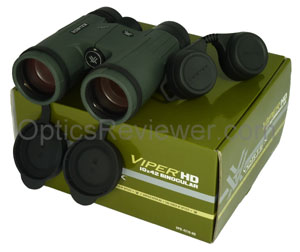
The Vortex Viper HD binoculars
are frequently discussed relative to the quality of the build,
but even more so the quality of the optics. We wondered if they were as good as some said and
if they were worth the price. So OpticsReviewer.com ordered a Viper HD binocular
to test and report the results to you. (We bought the Vortex Talon HD
and Razor HD binoculars, both of them also in the 10X42 configuration,
at the same time for fun.)
What makes high density (HD) glass special? HD glass, sometimes called "extra-low dispersion glass," is used for the same reason that lenses are made with the halide mineral fluorite. Lenses made from low dispersion glass exhibit less chromatic aberration, the blurring of color edges in images which makes them look "fuzzy." In addition to using fluorite, there are a number of ways of producing high-density glass and, while we don't know the process used for Vortex lenses, we can appreciate the difference it makes. As users have observed, the Vortex Viper HD binocular is quite good in low light conditions. In addition to considerations we'll mention later, we believe that some credit belongs to the HD glass and its reduction of chromatic aberration.
Had enough of the generalities? Shall we get into specifics for the Vortex Viper HD 10X42 binoculars review?
Body and Non-optical Components
Chassis
The Vortex Viper HD binocular's frame is made of polycarbonate to reach a light handling weight despite the weight of the glass inside it. (We couldn't find any information about what it was made from anywhere else — we went to Vortex for the answer.) Polycarbonate is a tough plastic commonly used in circumstances where it's important to reduce weight while maintaining strength.
At just 24.6oz/697g, the Viper HD is almost a couple of ounces lighter than its sibling, the Talon. It's also nearly an inch (23mm) shorter so that it looks a bit like a short-barreled binocular. We noted that thumb indents on the bottom of the Viper binocular barrel have an angle appropriate to the barrel length and lens weight distribution to prompt gripping the barrels for optimal balance.
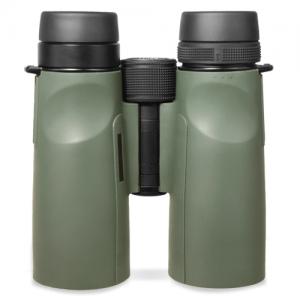
After using them for an extended period, our arms didn't have the fatigue that accompanies binoculars designed without attention to balance. This is important for anyone who uses hand-held binoculars more than occasionally. A birder on a migratory count, someone observing wildlife from an elevated observation stand, sports fans, and others will attest to this!
We found a comfortable grip, with average-size hands, just below the neck strap lugs which put our index fingers straight over the focusing wheel without any thought. Perhaps one factor for the designation of 42mm objective lenses as full-size binoculars was the barrel diameter providing a comfortable grip for most hand sizes. The test Viper binocular was easy to hold and focus with no noticeable difference between its closed-hinge design or an open-hinge design.
The Viper binocular's hard rubber armoring makes holding onto the instrument in wet and cold weather easier and more comfortable. Don't rely on it, however, to protect the Vortex Viper HD binocular's precision optics from knocking against rocks and trees or drops from any height. It's good, but we're confident that it's not intended to provide extraordinary protection!
Waterproof/Fog-proof
Although we're also confident that it's not part of the rubber armoring's job to waterproof the binocular the Vortex Viper HD binocular is both waterproof and internally fog-proof. It will still fog the exterior lenses if taken from a cool to a humid atmosphere and, in cold weather, holding the oculars up to your eyes can briefly fog their outside surface. But on the inside, where the moisture-containing air has been purged and replaced by argon gas, there isn't any moisture to fog the optics. The instrument has been sealed with O-rings to make it waterproof and keep the inside dry and fog-free.
The Vortex Viper binocular's fog-proof aspect also protects it against moisture-fed fungi growing on the instrument's internal glass surfaces. Fungal growth will etch the precious glass coatings and, over time, will eventually etch the glass if not killed.
Eyecups and Eye Relief
The Viper's twist-up, twist-down eyecups, as you might expect of a higher grade instrument, have greater adjustability than many. The Viper's eyecups extend in three, 3mm graduated steps with a distinct stop at each level. We had no difficulty with them slipping down a step when in use. With the Vortex Viper HD 10X42 binocular's eye relief of 16.5mm, this provides greater opportunity for personalization or optimization of the viewing experience.
The rim of the eyecups, which rests against your face, is rounded and not uncomfortable for those who don't wear eyeglasses.
Center Focus
We found that the Vortex Viper HD 10X42 binocular's central focus knob took 1.5 turns to go from close focus to infinity. That's the far end of what we like, but it's acceptable. When you're using an instrument for several hours of changing focus, you find a deep appreciation for a fast focus. Typically we prefer a binocular which goes from its close focus to infinity in one full turn of the focus wheel. The greater the amount of adjustment, the more tiring it is by the end of a day of observing activity at changing focal ranges.
The actual focusing was very smooth, however, as it would be expected to be.
Our Vortex Viper HD 10X42 was stamped with the serial number and the inscription "Made in Japan." Its mechanical construction was clearly above average and we didn't feel strained or fatigued because of mechanical or construction elements.
We'll move this Vortex Viper HD 10X42 review from a focus on the chassis and body aspects to considering its optics now.
Optical Configuration and Performance
Field of View
The linear field of view for the Vortex Viper HD 10X42 binocular is 319 feet at 1,000 yards (106.6m at 1,000m). With a 6.1° angular field of view, it's about average for a 10X42 binocular. We prefer a wider field of view because it offers the user a better view of activity and increased opportunity to see action that would otherwise be missed. The Viper HD binocular's usefulness across a wide spectrum of observing activities would be enhanced by a larger field of view. Is this a negative for the Viper? It could be, depending on your priorities and needs.
Optical Sweet Spot
A binocular's optical "sweet spot" is that area, usually in the center of the field of view, where it achieves its brightest colors, greatest contrast, and resolves details the best before the image normally begins to blur as you approach the field of view's periphery. We found the Viper's sweet spot to be a bit larger than what we consider to be average. The instrument we purchased to test for this Vortex Viper HD 10X42 binocular review presented a clear view for about 87% of the radius of the field of view before blurring of details became significant in our tests.
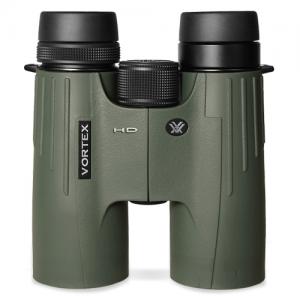
Is this blurring around the periphery of the view likely to affect your experience using the Viper HD 10X42? It's unlikely, although perhaps possible. We found it during specific optical testing designed to measure it, although we did not discern it during field testing.
We found the Vortex Viper HD binocular's resolution of detail to be above average when compared to instruments having neither HD glass/aspheric lenses nor a dielectric prism coating. When hand held the Viper HD provides a bright, well-contrasted and resolved view. Of course, the full resolution of an optical instrument is not realizable when it is hand held due to normal, minor body movements induced by breathing, heart beats, and so on.
In order to fully appreciate the details viewable through the Viper HD binocular, it should be tripod mounted using the optional tripod adapter whenever possible. A full-size binocular that resolves detail at this level or greater will provide a wealth of detail you'll never be able to see while holding them unassisted. (Farmers/ranchers, law enforcement, and others who routinely use binoculars from a vehicle should get a window mount to use with the optional tripod adapter and use it with the vehicle's engine shut off to eliminate its vibration. The window mount and adapter can be used with most other binoculars with tripod provisions.)
Initial views through any glass with high density or extra-low dispersion glass lenses are not likely to fully appreciate the improved view. After becoming accustomed to one over a period of days or weeks and then using a binocular without HD/ED glass, however, you'll quickly note the difference in the views' clarity and crispness.
Why is the view better? We believe the difference to be largely based in a combination of the fully multi-coated glass surfaces and the XR proprietary anti-reflective coating Vortex applies, the high density/extra-low dispersion glass used for lenses, and the dielectric prism coating used for the Viper HD binocular. All of these work together to provide a crisp, clear, clean image to the eye. It seems to work well in the Viper HD.
How did the Viper HD's high density glass deal with chromatic aberration? We looked specifically for chromatic aberration with light objects against dark backgrounds and dark objects against bright backgrounds and light sources at night. We did not note chromatic aberration.
Does the Viper HD binocular have "rolling ball"/globe distortion? We found that the Viper has a small amount of pincushion distortion built into it to get rid of the rolling ball effect. (The rolling ball effect can actually produce nausea in some individuals.) This is the customary approach to eliminating the rolling ball effect and it is only observable around the periphery of the field of view. Will you notice it during use? It's quite unlikely that the slight amount of pincushion engineered into the Viper HD binocular's optics will be noticeable during field use.
The Viper HD binocular's diopter is adjusted by means of a ring at the base of the right ocular. This individually adjusts the binocular's right side optics to provide a well-focused view for both eyes. The Viper HD diopter ring is normally locked and slides out (toward the eyepiece) to unlock it so the diopter can be adjusted. We prefer a locking diopter adjustment such as this because it works to ensure that regular use and handling of the instrument doesn't unexpectedly change the diopter setting.
Exit Pupil
The exit pupil of 4.2mm is likely adequate for most uses on land. You'd want a larger exit pupil for use on marine vessels to accommodate the roll from swells or waves and still be able to keep an image in view.
Colors
We found colors viewed through the Viper HD binocular to be unaffected by its optics. Distinguishing between shades of various colors was not difficult. Color edges were well-defined and clear. Chromatic aberration was not observed while testing or under field conditions.
Low Light Viewing
We found the Vortex Viper HD 10X42 binocular's fully multi-coated, dielectric coated BaK-4 prisms, and high-density lenses to push back into the shadows quite effectively. This was true whether viewing at dawn/dusk or when viewing from sunny, well-lighted areas into dark shadows. While shadow penetration would not be expected to be as good at night, we observed that the optics made good use of available light and provided better views than the naked eye. The low-light views were bright - meaning the colors were bright, had good contrast, and crisp resolution - at both dawn and dusk as well as on overcast days.
Strong Light Viewing
Looking through the objective lens it's possible to observe the baffling inside the barrels to reduce or eliminate the amount of stray light that might otherwise be reflected inside the barrels and interfere with a good viewing experience. Such baffling is an integral part of the design of a good binocular's optical system.
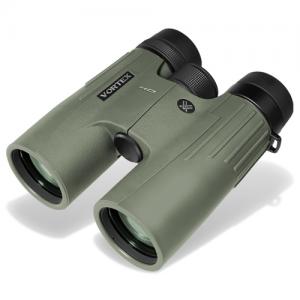
To test the Viper HD optics' ability to control stray light when used under strong light viewing conditions, we focused on bright lights illuminating an area where cars were parked at night. We observed a modest number of medium-length spikes. The baffling was performing well and this would account for our not noticing reflected glare when viewing ducks on water when the rising sun was at a 90° angle to our direction of view. We also looked in the general direction of the rising or setting sun (perhaps 35-45° away from the sun) and observed a small amount of glare at one side of the viewed image - good performance at this price point.
Close Focus
Vortex claims a close focus distance of 5.1 feet (1.6m) for the Viper HD 10X42 configuration. We measured the close focus at 4.7 feet (1.4m) and well within the specification. That may be enough to persuade put the Viper HD on some birders' and butterfly watchers' shopping lists - it's a very good close focus. That's significantly better than the 8.0 feet we consider an ideal for birders and might make this an ideal binocular for entomologists.
If you regularly use a binocular's close focus for purposes other than checking out details on nearby birds, dragonflies, butterflies, etc, please send us a note through our contact page - we're curious!
What Comes With It?
Case
Also in the Vortex Viper HD 10X42 binocular's box was a soft black nylon carrying case with about a quarter inch (6mm) of padding which felt similar to the closed-cell foam used for notebook/laptop computer travel cases. There is a mesh pocket with zipper inside the cover - a good place to keep a lens cleaner or two. A shoulder strap, which clips onto the sides of the case, is included and there are two, sturdy belt loops sewn on the back of the case.
There is a little room to spare in the case and might be enough to accommodate a light scarf, thin pair of gloves, or slender bird guide.
The Vortex Viper HD binocular comes with a rain guard for the oculars (eyepieces) which is made of a softer, durable-feeling rubber that's about an sixteenth of an inch (1.6mm) thick. It has a flexible bridge between the two caps that fit over the oculars. The caps that fit over the oculars appear to have a slight taper so that, while they fit easily, they don't usually slip off unexpectedly. The caps measure about three quarters of an inch (19mm) deep.
Covers are also provided for the objective lenses and appear to be made of the same quality of rubber as the rain guard. They fasten to the binocular by means of a loop sliding over the end of the barrel - from which the lens covers hang when not in use. While we like the quality of these lens covers, we're also mindful of the probability of their getting lost during a vigorous day outside. We found that sliding them off at the beginning of an outdoor excursion and tucking them into the carrying case saved them to protect the lenses from scratching on the way home.
Other Items
Also included with the Vortex Viper was a comfortably padded neoprene neck strap. Shoulder harnesses are now available from numerous retailers, should you find them more comfortable or practical. A lens cleaning cloth was part of the package - a nice touch for when you need something in the field and nothing else you have with you will quite do. And, finally, an instruction pamphlet which describes a variety of important things such as adjustments to the instrument's eyecups, interpupillary distance, and diopter. It also gives good lens care guidance.
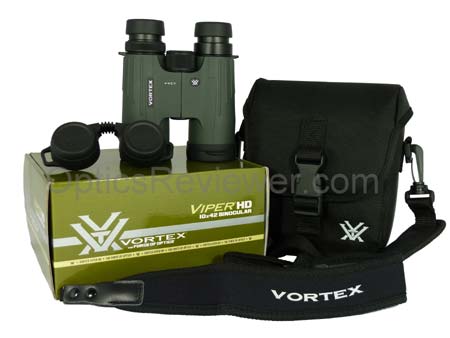
Recommendation
Although the Vortex Viper HD 10X42 binocular's field of view is "only" average, we consider it to provide very good optics and mechanical build in its price range. We like the Viper HD don't hesitate to suggest it - especially for bird watching, wildlife observation, stadium sports, hunting and other general optics uses.
While you may find higher prices, you'll not find the Viper HD sold at prices lower than the ones at
Amazon.com and
Amazon.co.uk
.
Because we were just as curious as anyone else, we've also compared the Viper HD binocular with the Bushnell Elite ED and Nikon Monarch 7 binoculars. We're happy to share our thoughts through our comparison of Monarch 7, Elite ED and Viper HD article.
The Talon HD and Viper HD are close enough in price that visitors to OpticsReviewer.com wondered what they would be like in a side-by-side comparison. Also, many who were interested in the Viper HD were also wondering what the Razor HD was like and vice versa. We put together a summary, leaving out most of our opinions and interesting things that are in the full reviews, and tried to present just what we felt were the more significant things we found in working with the Talon HD, Viper HD, and the Razor HD. If you're wondering what we noted, it's in the Talon HD vs Viper HD vs Razor HD article.
Vortex calls its optics warranty its Very Important Promise (VIP) and it's fully transferrable should you give or sell a Vortex binocular to someone else. A receipt or a registration card is not necessary to obtain service under the warranty. Vortex will, at its option, repair or replace a damaged binocular. We don't know of a better warranty.
| Configuration | 6X32 | 8X32 | 8X42 | 10X42 | 10X50 | 15X50 |
|---|---|---|---|---|---|---|
| Dielectric Prism Coating | Yes | Yes | Yes | Yes | Yes | Yes |
| Field of View at 1,000 yd/m ft/m | 420/ 140.4 | 400/ 133.7 | 347/ 116.9 | 319/ 106.6 | 278/ 92.9 | 210/ 70.2 |
| Close Focus Distance ft/m | 3.0/0.9 | 3.0/0.9 | 5.1/1.6 | 5.1/1.6 | 8.2/2.5 | 8.2/2.5 |
| Exit Pupil (mm) | 5.3 | 4.0 | 5.3 | 4.2 | 5.0 | 3.3 |
| Relative Brightness | 28.1 | 16.0 | 28.1 | 17.6 | 25.0 | 10.9 |
| Eye Relief (mm) | 19.5 | 16.0 | 20.0 | 16.5 | 19.5 | 16.0 |
| Weight oz/g | 20.6/ 584 | 20.6/ 584 | 24.2/ 686 | 24.6/ 697 | 28.4/ 805 | 28.4/ 805 |
| Inter-pupillary Distance (mm) | 59-75 | 59-75 | 59-75 | 59-75 | 59-75 | 59-75 |
Home > Vortex Binoculars > Vortex Viper HD Review


Your Comments
This site is for you, our readers. We appreciate your comments very much.